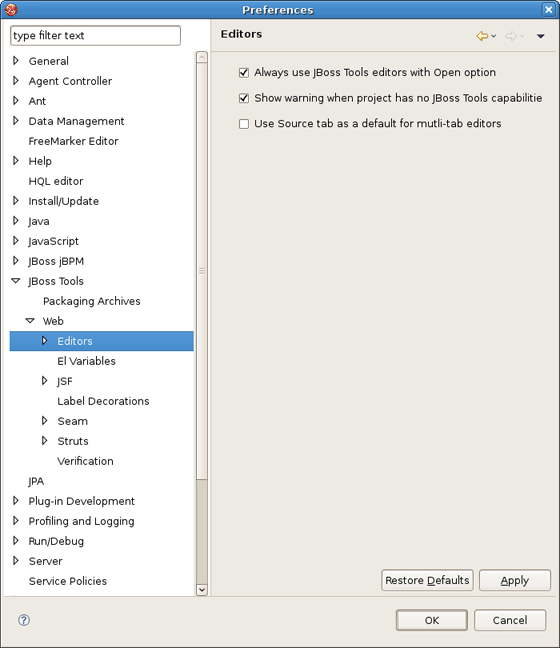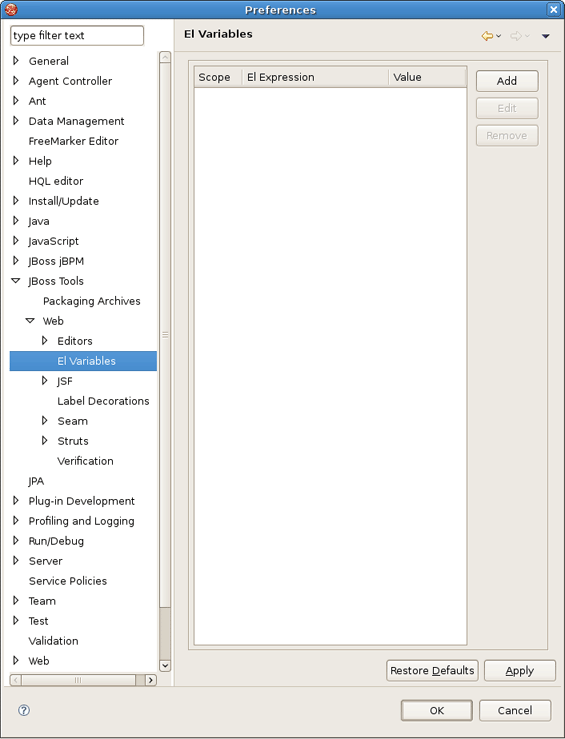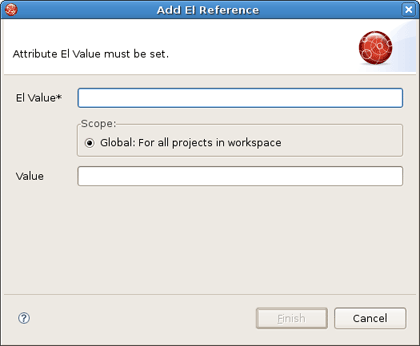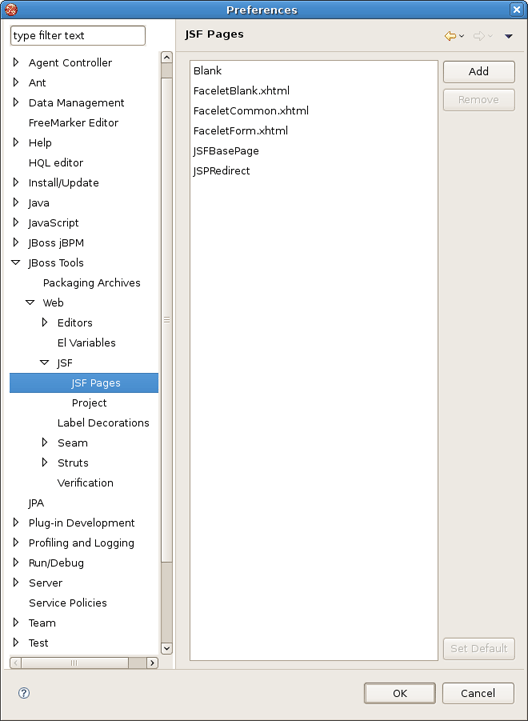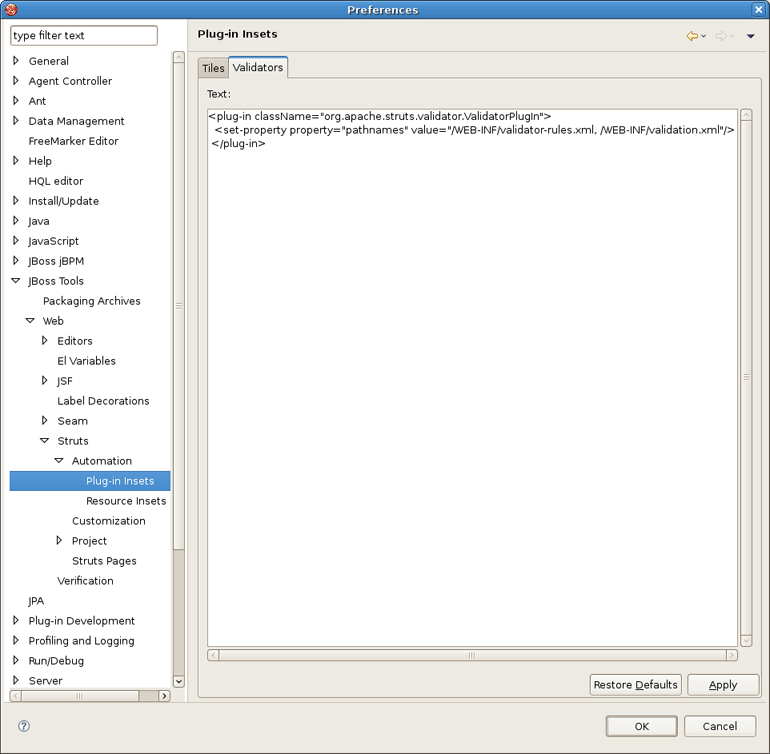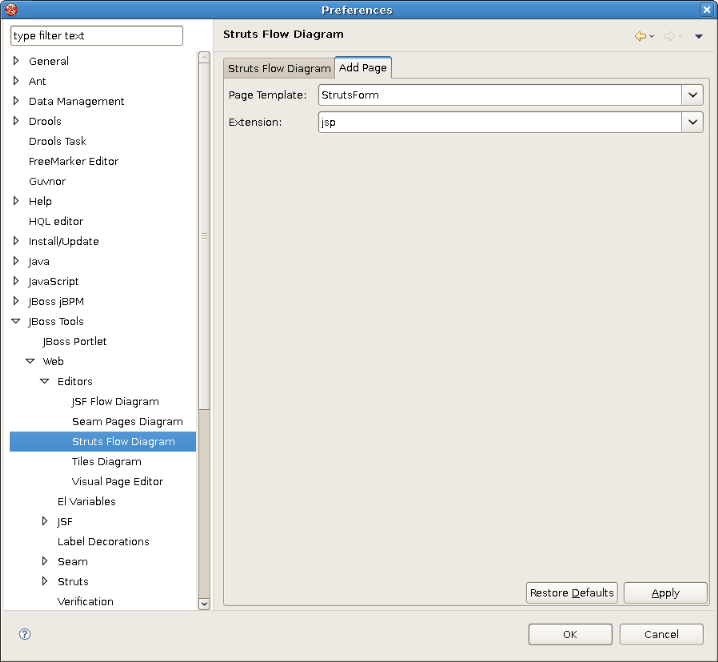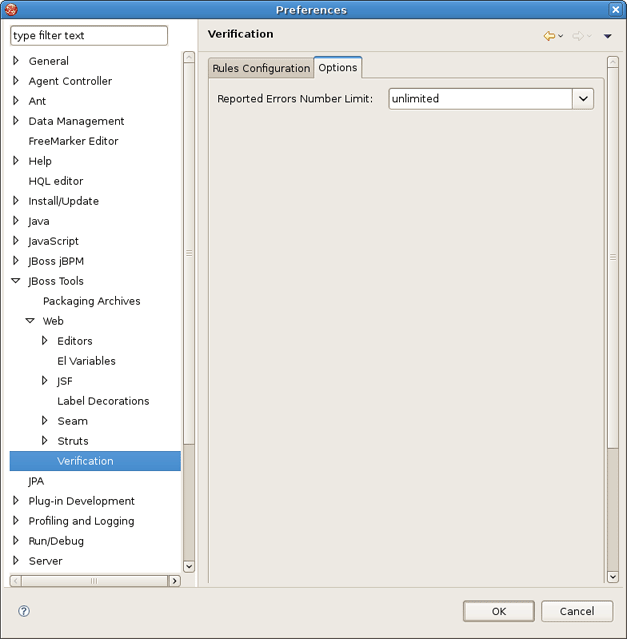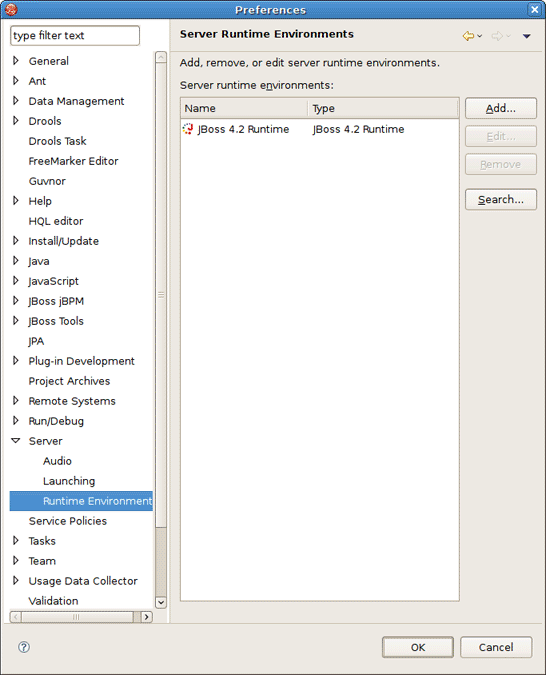- 7.1. Packaging Archives
- 7.2. Editors
- 7.3. Visual Page Editor
- 7.4. El Variables
- 7.5. JSF
- 7.6. JSF Pages
- 7.7. JSF Project
- 7.8. JSF Flow Diagram
- 7.9. Label Decorations
- 7.10. Seam
- 7.11. Seam Validator
- 7.12. <diffmk:wrapper>Seam Pages Diagram</diffmk:wrapper>
- 7.13. Struts
- 7.14. Struts Automation
- 7.15. Plug-in Insets
- 7.16. Resource Insets
- 7.17. Struts Customization
- 7.18. Struts Project
- 7.19. Struts Support
- 7.20. Struts Pages
- 7.21. Struts Flow Diagram
- 7.22. Tiles Diagram
- 7.23. Verification
- 7.24. Server Preferences
- 7.25. XDoclet
Configuring the various JBoss Developer Studio features is done via the Preferences screen by selecting Window > Preferences > JBoss Tools from the menu bar.
From this screen, you can select these more specific sets of JBoss Tools preferences:
The Preferences dialog ( Window > Preferences) also allows to adjust settings for JBoss Server and XDoclet module.
Fallow to JBoss Tools > Packaging Archives to open the page for changing Packaging Archives preferences.
Here you can determine settings for Project Packages view and core preferences.
The next table lists all available preferences for Packaging Archives and their description.
Table 7.1. Packaging Archives Preferences
| Option | Description | Default |
|---|---|---|
| Enable incremental builder | Uncheck this option if you don't want to enable incremental builder for your resources | On |
| Show full output path next to packages | This option allows you to show or hide an output path next to packages . | On |
| Show the full root directory of filesets | If on, the full root directory is displayed next to filesets. Otherwise, it's hidden . | On |
| Show project at the root | This option allows you to choose whether to display a project name at the root of the packages or not. When checked, 'Show all projects that contain packages' is enabled . | On |
| Show all projects that contain packages | Selecting this setting enables the Projects Archiving view to show or hide all projects that contain packages. The option is available when the previous one is checked. | Off |
To adjust settings common for all editors supplied with JBoss Developer Studio you should select JBoss Tools > Web > Editors.
On the Editors page the following preferences are available:
Table 7.2. Editors Preferences
| Option | Description | Default |
|---|---|---|
| Always use JBoss Tools editors with Open option | On | |
| Show warning when project has no JBoss Tools capabilities | Check this option to be sure that any JBoss Tools editor fully available for a particular type of file. If no, you'll be warned about this. | On |
| Use Source tab as a default for multi-tab editors | If on, an editor will open the files in the Source view by default | Off |
JBoss Tools > Web > Editors > Visual Page Editor screen allows you to control some aspects of the behavior of the Visual Page Editor (VPE) for JSF/HTML files.
The next table lists the possible settings that you can adjust on the General tab of the VPE Preferences page.
Table 7.3. VPE Preferences
| Option | Description | Default |
|---|---|---|
| Show Border for Unknown Tags | The option allows to place the border around unknown tags or undo this | On |
| Show Non-Visual Tags | Check this box, if you want the editor shows non-visual elements on the page you're editing | Off |
| Show Resource Bundles Usage as EL Expressions | If the option is checked, the editor will show EL expressions instead of the resource values | Off |
| Always Prompts for Tag Attributes During Tag Insert | Having this option off, the dialog with possible attributes for inserting tag won't appear if all its attributes are optional | On |
| Show Selection Tag Bar | This option allows to show or hide the Selection Bar | On |
| Always Hide Selection Bar Without Prompt | Check this box if you don't want the confirmation window appears when closing the Selection Bar | Off |
| Default Editor Tab | The option provides with a possibility to choose one of the following views - Visual/Source, Source or Preview, as default when opening the editor | Visual/Source |
| Size of Visual Editor Pane 0 – 100% | With the help of this scroll bar you can adjust the percentage rating between the Source and Visual modes of the Visual/Source view | 50% |
On the Templates tab you can edit or remove VPE templates.
Select a template for editing from the available list and press Edit button. It will pick up the Template dialog where you can adjust new settings.
To specify necessary EL variables globally, i. e. for all projects and resources in your workspace, you should go to JBoss Tools > Web > El Variables.
Click Add... to set value for a new EL variable. In the appeared wizard you should specify the global values and press Finish .
Tip:
If you specify an equal variable in VPE EL dialog and in Preference EL dialog, variable from preference dialog will have priority.
Select JBoss Tools > Web > JSF to get to the JSF Project specific preferences.
By selecting JBoss Tools > Web > JSF > JSF Pages you can add jsf pages or remove existing ones.
Select JBoss Tools > Web > JSF > Project to see JSF Project preferences page.
On the New Project tab you can set default values for New JSF Project wizard:
Version for setting the default JSF Environment
Project Template so as New JSF Project wizard shows this template as default for the chosen JSF Environment
Project Root for specifying default location for a new JSF project
If you check Use Default Path here, this box will be also checked in the New JSF Project wizard.
Servlet Version for setting the default Servlet version of a new JSF project
Here it's also possible to define whether to register Web Context in server.xml while organizing a new project or not. Check the proper box in order to do that.
On the Import Project tab in the JSF Project screen you can determine the default Servlet version for the Import JSF Project wizard and also whether to register Web Context in server.xml or not.
Selecting JBoss Tools > Web > Editors > JSF Flow Diagram allows you to specify some aspects of the Diagram mode of the JSF configuration file editor.
The first two items control the background grid for the diagram. The next two items allow you to control the appearance of the labels for views (pages) and the transitions between views. For these two items, clicking the Change... button allows you to assign a font with a dialog box.
The first check box determines whether a view in the diagram that doesn't have a transition connecting it to another view yet should be written to the source code as a partial navigation rule. The next check box determines whether the diagram cursor reverts immediately to the standard selection mode after it's used in the transition-drawing mode to draw a transition. Finally, the last two check boxes concern shortcuts. A shortcut is a transition that is there but isn't actually displayed in the diagram as going all the way to the target view it's connected to, in order to make the diagram clearer. With the check boxes, you can decide whether to display a small shortcut icon as part of the shortcut and also whether to display the target view as a label or not.
Selecting the Add Page tab in the JSF Flow Diagram screen allows you to determine the default template and file extension for views (pages) you add directly into the diagram using a context menu or the view-adding mode of the diagram cursor.
The Label Decorations page is opened from JBoss Tools > Web > Label Decorations.
On this page you can determine the format for a text output near the decoration label for different Web resources. To change the value for selected element, click Add Variable... button next to Format field. Appeared wizard will prompt you to select one from the available list.
The following preferences can be changed on the JBoss Tools > Web > Seam page.
On Seam screen you can add and remove Seam runtimes.
Here is what Seam preference page looks like:
The following preferences can be changed on the JBoss Tools > Web > Seam > Validator page.
In Validator panel you configure seam problems that will be processed by validator.
<diffmk:wrapper>In order to customize the layout of the Diagram used for editing and composing </diffmk:wrapper><diffmk:wrapper>page.xml</diffmk:wrapper><diffmk:wrapper> file in </diffmk:wrapper><diffmk:wrapper>Graphical mode</diffmk:wrapper><diffmk:wrapper> of </diffmk:wrapper><diffmk:wrapper>Seam Pages Editor</diffmk:wrapper><diffmk:wrapper> you can go to </diffmk:wrapper><diffmk:wrapper>Window > Preferences > JBoss Tools > Web > Seam > Editors > Seam Pages Diagram</diffmk:wrapper><diffmk:wrapper>. </diffmk:wrapper>
By selecting JBoss Tools > Web > Struts you can configure Struts projects specific preferences.
On Automation <diffmk:wrapper> panel you can modify default text for the Title Struts plug-in element, the Validator Struts plug-in element, and error message resource files.</diffmk:wrapper>
By selecting Web > Struts > Automation > Plug-in Insets on tab Tiles you can define a default text for tiles plugin.
The same is done but for validator plugin on the tab Validators.
To see Resource Insets preference page select JBoss Tools > Web > Strats > Automation > Resource Insets .
On Resource Insets panel you determine default error messages for error resource files.
The following preferences can be changed on the JBoss Tools > Web > Struts > Customization page.
In the Customization screen you configure Link Recognizer for Struts tags.
You can change the following preferences on the JBoss Tools > Web > Struts > Project preference page:
On Project panel you define a template for a new Struts created project: servlet version, page template and so on.
Selecting the Import Project tab in the Struts Project screen allows you to determine the default servlet version and whether to register Web Context in server.xml.
The following preferences can be changed on the JBoss Tools > Web > Struts > Project > Struts Support page.
Select Struts Support screen if you want to configure Struts versions support settings.
You can change the following preferences on the JBoss Tools > Web > Struts > Struts Pages preference page.
On Struts Pages panel you can add or remove Struts pages.
Similarly to the JSF Flow Diagram screen, selecting JBoss Tools > Web > Editor > Struts Flow Diagram page allows you to specify aspects of the Diagram mode of the Struts configuration file editor. The Struts Flow Diagram screen adds an option to hide the Diagram tab and labeling settings for additional artifacts.
Selecting the Add Page tab in the Struts Flow Diagram screen allows you to determine the default template and file extension for views (pages) you add directly into the diagram using a context menu or the view-adding mode of the diagram cursor.
JBoss Tools > Web > Editors > Title Diagram screen allows you control some settings for the placement of Tiles definitions in the Diagram mode of the JBoss Tools Tiles editor.
The following preferences can be changed on the JBoss Tools > Web > Verification page.
On Rules Configuration tab of <diffmk:wrapper>Verification</diffmk:wrapper> panel you can determine JSF and Struts rules.
On Options tab you can define a limit for the reported errors number.
Preferences for JBoss Server and other servers can be changed on the Server page.
On the Server > Runtime Environments page you can add new or modify already defined Server Runtime.
Server Launching preferences can be configured on the Server > Launching page.
Going to Server > Audio you can enable/disable the sound notification for different Server states and actions and set the sound volume as well.
The preferences for XDoclet can be changed if you click XDoclet on the left navigation bar.
On the XDoclet screen it's possible to enable/disable XDoclet builder by checking proper box, specify XDoclet home and determine XDoclet module version as well.
Switch to XDoclet > ejbdoclet page in order to adjust settings for EJB-specific sub-tasks.
To configure settings for various web-specific XDoclet sub-tasks, follow to XDoclet > webdoclet page.
On the whole, this document should guide you to those parts of JBoss Tools which you specifically need to develop Web Applications. It covers different aspects of visual components such as editors, views, etc. for browsing, representing and editing web resources you are working with.
If there's anything we didn't cover or you can't figure out, please feel free to visit our JBoss Developer Studio Users Forum or JBoss Tools Users Forum to ask questions. There we are also looking for your suggestions and comments.


